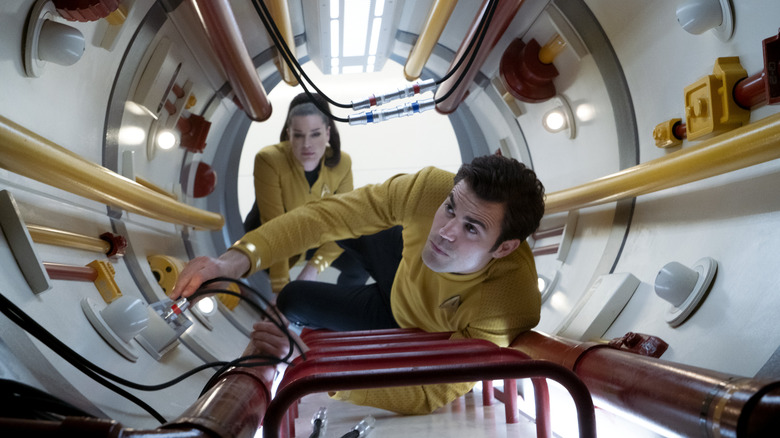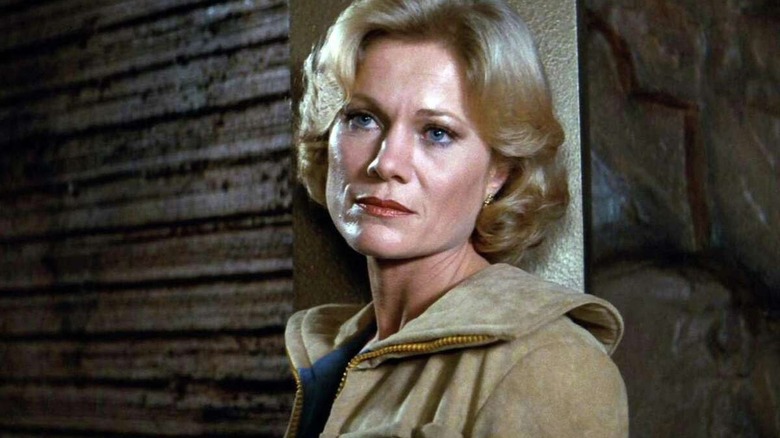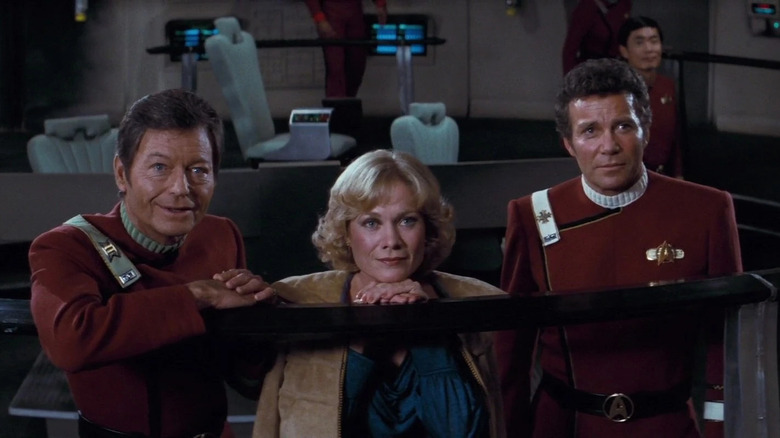Star Trek: Strange New Worlds Flips A Switch On Kirk's Heartbreaking Backstory
This post contains spoilers for the latest episode of "Star Trek: Strange New Worlds."
In the latest episode of "Star Trek: Strange New Worlds," "Subspace Rhapsody," the crew of the Enterprise falls under the influence of a mysterious psychic field that is activated by a broadcast of Cole Porter's "Anything Goes." The crew becomes unable to keep its emotions hidden, and individuals find themselves confessing their more passionate inner lives ... in song. "Subspace Rhapsody" is a full-blown musical.
As established in "Tomorrow and Tomorrow and Tomorrow," Lieutenant La'an Noonien-Singh (Christina Chong) has developed a powerful romantic attraction for James T. Kirk (Paul Wesley). This was complicated for her, however, as the Kirk she met hailed from an alternate timeline that was ultimately erased (dating in "Star Trek" seems quite difficult). In La'an's native timeline, however, Kirk is still alive, and she has to wrestle with the fact that she is intensely attracted to a man who has no memory of their time together. In "Subspace Rhapsody," Kirk visits the Enterprise, and La'an, thanks to the singing epidemic, has to confess her feelings for him. Kirk admits, however, that he cannot pursue anything with La'an ... because he's already in a relationship. He says that he's been periodically dating a woman named Carol and that she's pregnant with his child. La'an hadn't counted on that.
The name Carol will instantly ring a lot of bells in Trekkies' minds. In Nicholas Meyer's 1982 film "Star Trek II: The Wrath of Khan," Kirk (William Shatner) is reunited with an old flame named Dr. Carol Marcus (Bibi Besch), the developer of an instantaneous terraforming technology called the Genesis Wave. Kirk is also reunited with his son David (Merritt Butrick), now a bitter young man who never knew his father.
"Star Trek II" made Kirk look like a deadbeat dad. "Subspace Rhapsody" attempts to recontextualize that interpretation.
Dr. Carol Marcus
Kirk doesn't call the off-screen Carol by her full name, but it's safe to assume it's Dr. Carol Marcus.
The dialogue in "Star Trek II" between Kirk and Dr. Marcus is full of quiet animosity, but an attempted understanding. Both characters are wholly devoted to their careers, and although they had a child together, they agreed — at some point in the past — to stay apart. David grew up resenting Kirk, seeing him as a violent military man that he wanted nothing to do with. The sudden introduction of an estranged son and abandoned lover reflected poorly on Kirk, but also lent important thematic underpinnings to "Star Trek II." The film is largely about getting older and facing the consequences of one's actions. Kirk is middle-aged and no longer has the luxury of galavanting away from his problems under the auspices of his career. Having a son indicates that he finally needs to take responsibility for things. "Star Trek II" implies that Kirk, as a younger man, was reckless and blasé.
At best, Kirk was someone who had to leave behind a pregnant girlfriend under a mutual understanding. At worst, he knowledgeably ignored Dr. Marcus and absquatulated with his career intact.
"Star Trek: Strange New Worlds" is set just a few years before the events of the original "Star Trek" series, and, given David's age in "Star Trek II," it syncs up that Kirk would be fathering his son at about this time. "Subspace Rhapsody" seems to reclaim Kirk's caddish reputation, staging him as a man who would happily stay with Dr. Marcus and raise their child, but also that his relationships can be fraught and complicated. He is not a wild sexual cowboy as his popular reputation might suggest.
Kirk's popular perception
The popular perception of Captain Kirk is, even to this day, that of a careless lothario. Yes, in the original "Star Trek" series, Kirk kissed his share of beautiful women, but Kirk's sexual prowess was rarely a plot point. Indeed, he was more often presented as a judicious, even serious starship commander, approaching most situations with logic and thought. This pop image of Kirk likely emerged in reruns, wherein Trekkies could watch key scenes back-to-back and form a rendition of Kirk that presented him as a sexual dynamo. "Star Trek II" tried to humble Kirk in light of his reputation.
The Kelvin-verse "Star Trek" movies ran in the opposite direction, presenting a young Kirk (Chris Pine) as a sex-crazy super-stud who had threesomes on the regular, and who was instantly attracted to a young Dr. Marcus (Alice Eve), presented in her underwear. The Kelvin movies weren't so much a new version of "Star Trek" as they were the non-Trekkies' popular image of "Star Trek" presented literally. Kirk's romantic recklessness was a big part of the character in those movies.
"Strange New Worlds," in contrast, is rescuing Kirk from his reputation. This younger man is a mite brash but presented as friendly, compassionate, clear-headed, and even sympathetic. The SNW version of young Kirk doesn't need to grow out of his "wild oats" period, he needs to harden into an adult. He's actually a lot more sensitive as a young man in "Strange New Worlds" than in the Kelvin-verse. He thinks about Dr. Marcus a lot and wants to do right by her.
"Subspace Rhapsody" turns Kirk's womanizing into a myth. He may be destined to abandon Dr. Marcus, but we now know that he never wanted to. He is not reckless. He is haunted.


